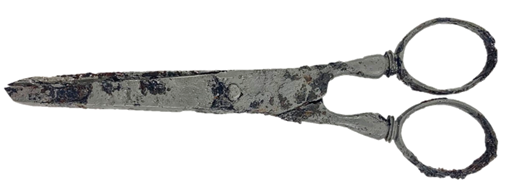By Heather Hembrey, M.A., M.A.A.
Fairfax County’s archaeological collections contain artifacts from many sites where women once lived and worked. For Women’s History Month, artiFACTS features a small pair of scissors unearthed at the Thomas Brown farm site.

In the early 1740s, western Fairfax County was largely unsettled and undeveloped. Farmers like Thomas Brown who couldn’t afford to buy land, rented there until they could purchase their own. In 1742, Thomas leased 150 acres from Willoughby Newton. Later, in 1761, he purchased 400 acres near present-day Ellanor C. Lawrence Park, thus rising in status from tenant to landowner. By 1770, he had built a house and was running a prosperous tobacco plantation.
Thomas purchased goods from Colchester merchants Glassford and Henderson. His accounts reflect the Browns’ increasing wealth and show evidence of women’s domestic activities, including sewing. In September 1766, Brown bought “1 hank silk, 2 skeins twist [yarn].” In November 1769, he purchased “3 sets netting needles”. He likely purchased these steel scissors. They are 4.75 inches long and decorated with bands beneath the finger holes.
In 1770, the Brown household included several enslaved laborers including Hannah, Judith, Kate, Lucy, Adam, Brister, and Charles. Hannah, Judith, Kate and Lucy likely helped Elizabeth Brown with domestic tasks such as cooking, gardening, tending animals, and sewing. It took a great deal of sewing to create and maintain the clothing, linens, blankets and other household textiles that served the members of the household.
When the Brown house site was excavated in the 1990s, these scissors were among the rich concentration of mid-18th-century artifacts that date to the time of the Browns’ occupation. Once the archaeological work was completed, the site was destroyed by the I-66 Route 28 Improvements Project. Nothing of the Browns’ farm remains, nor do we have images of Thomas, Elizabeth, or the enslaved people within the household. Yet these scissors survive to represent the many tasks that the women – enslaved and free - undertook to maintain Brown’s plantation.

